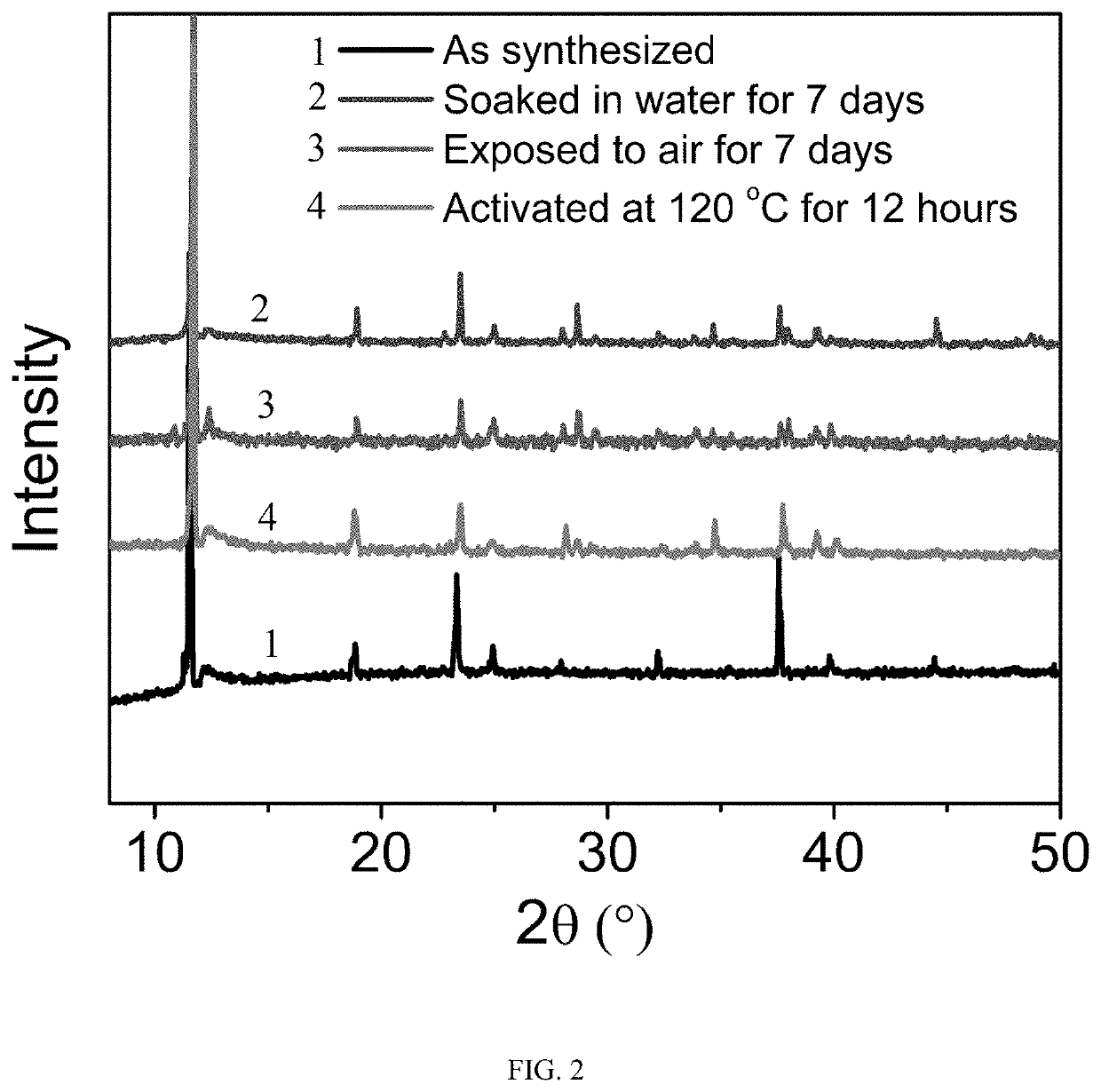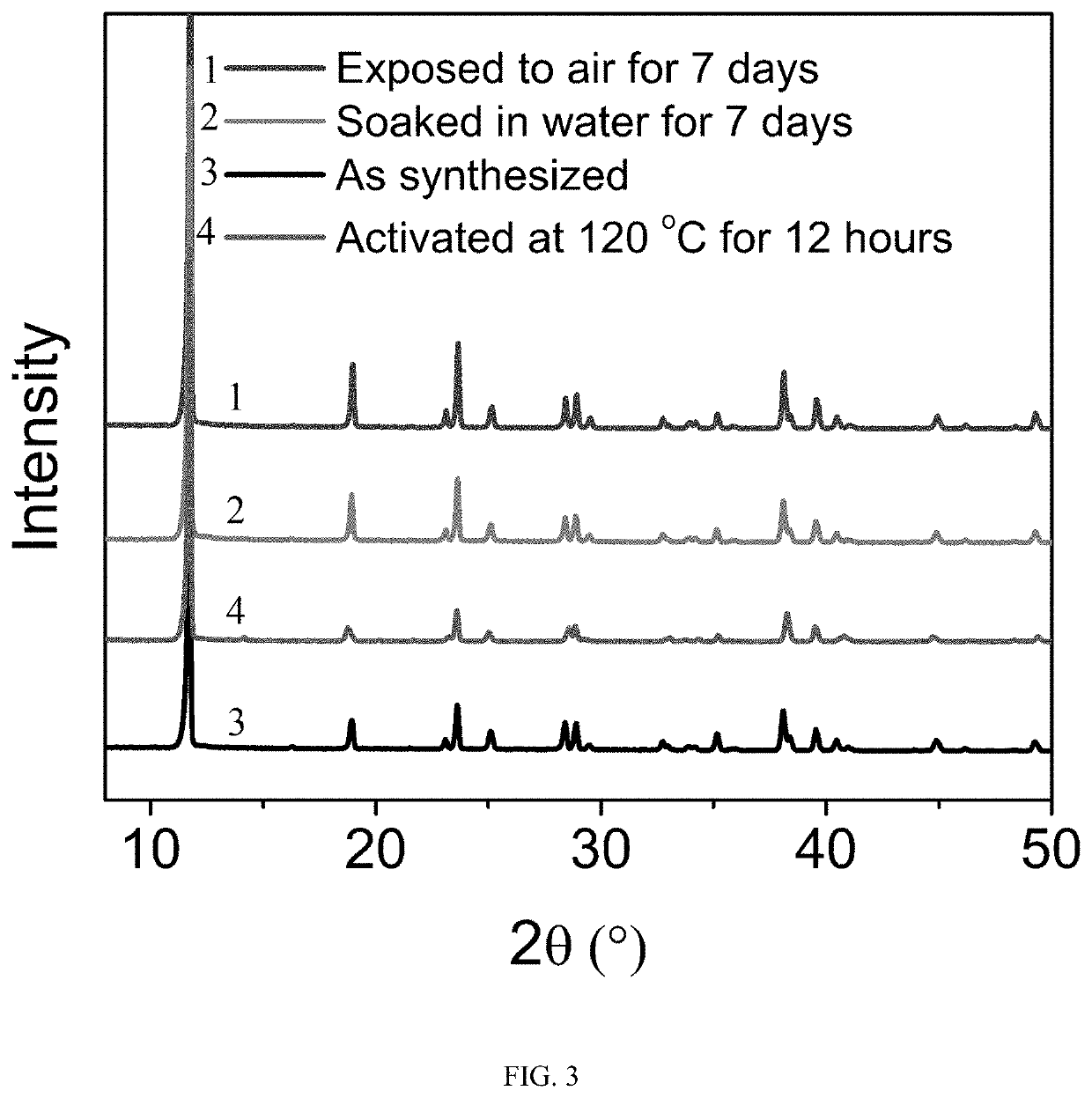Method for adsorption and separation of propylene, propyne, propane and propadiene
a technology of propylene and propane, applied in the field of adsorption materials and energy sources, can solve the problems of complex composition of coiled products, need of noble metal catalysts, and difficult separation of propylene/propyne/propadiene, etc., and achieves simple purification steps, easy operation and scale-up, and mild synthesis conditions.
- Summary
- Abstract
- Description
- Claims
- Application Information
AI Technical Summary
Benefits of technology
Problems solved by technology
Method used
Image
Examples
embodiment 1
[0037]0.151 mmol calcium carbonate and 0.151 mmol squaric acid were added into 20 mL deionized water and stirred for 30 minutes before transferred into a 25 mL hydrothermal reactor. Then the reactor was kept at 120° C. for 24 hours. After the reaction was completed and cooled down, a purified metal-organic framework material was obtained after washed with pure water several times. Prior to gas adsorption experiments, the purified adsorbent was activated at 100° C. under vacuum for 12 hours to obtain the solvent-free samples.
[0038]The single-component adsorption isotherms of propylene, propyne, propane and propadiene were performed on the above adsorbent with an appropriate amount at 0° C. and 25 ° C. The adsorption capacities of propylene, propyne, propane, and propadiene were 2.9, 3.3, 2.7 and 3.5 mmol / g, respectively, at 0° C. and 1 bar. The adsorption capacities of propylene, propyne, propane, and propadiene were 1.3, 2.8, 0.3 and 3.0 mmol / g, respectively, at 0° C. and 0.01 bar. ...
embodiment 2
[0040]1.93 mmol cobalt chloride hexahydrate, 2.88 mmol squaric acid, and 7.72 mmol potassium hydroxide were added into 7 mL deionized water and stirred for 30 minutes. Then transferred into a 25 mL hydrothermal reactor and kept at 220° C. for 48 hours. After the reaction was completed and cooled down, a purified metal-organic framework material was obtained after washed with pure water several times. The purified adsorbent was degassed at 120° C. under vacuum for 12 hours to obtain a solvent-free adsorbent before the gas adsorption measurements.
[0041]In order to test the stability of the sample, the sample was exposed to air under a relative humidity of 60% for 7 days and immersed in pure water for 7 days before PXRD measurements. The PXRD curves were shown in FIG. 2. From the results, whether it was immersed in water for 7 days or exposed to air with a relative humidity of 60% for 7 days, the PXRD of the samples were consistent with the original synthesized one, indicating the exce...
embodiment 3
[0042]1.93 mmol nickel chloride hexahydrate, 2.88 mmol squaric acid and 7.72 mmol potassium hydroxide were added into 7 mL deionized water and stirred for 30 minutes. Then transferred into a 25 ML hydrothermal reactor and kept at 220° C. for 48 hours. After the reaction was completed and cooled down, a purified metal-organic framework material was obtained after washed with pure water several times. The purified adsorbent was degassed at 120° C. under vacuum for 12 hours to obtain a solvent-free adsorbent before the gas adsorption measurements.
[0043]In order to test the stability of the sample, the sample was exposed to air under a relative humidity of 60% for 7 days and immersed in pure water for 7 days before the PXRD measurements. The PXRD curves were shown in FIG. 3. From the results, whether it was immersed in water for 7 days or exposed to air under a relative humidity of 60% for 7 days, the PXRD curves of the samples were consistent with the original synthesized one, indicati...
PUM
| Property | Measurement | Unit |
|---|---|---|
| total pressure | aaaaa | aaaaa |
| temperature | aaaaa | aaaaa |
| total pressure | aaaaa | aaaaa |
Abstract
Description
Claims
Application Information
 Login to View More
Login to View More - R&D
- Intellectual Property
- Life Sciences
- Materials
- Tech Scout
- Unparalleled Data Quality
- Higher Quality Content
- 60% Fewer Hallucinations
Browse by: Latest US Patents, China's latest patents, Technical Efficacy Thesaurus, Application Domain, Technology Topic, Popular Technical Reports.
© 2025 PatSnap. All rights reserved.Legal|Privacy policy|Modern Slavery Act Transparency Statement|Sitemap|About US| Contact US: help@patsnap.com



